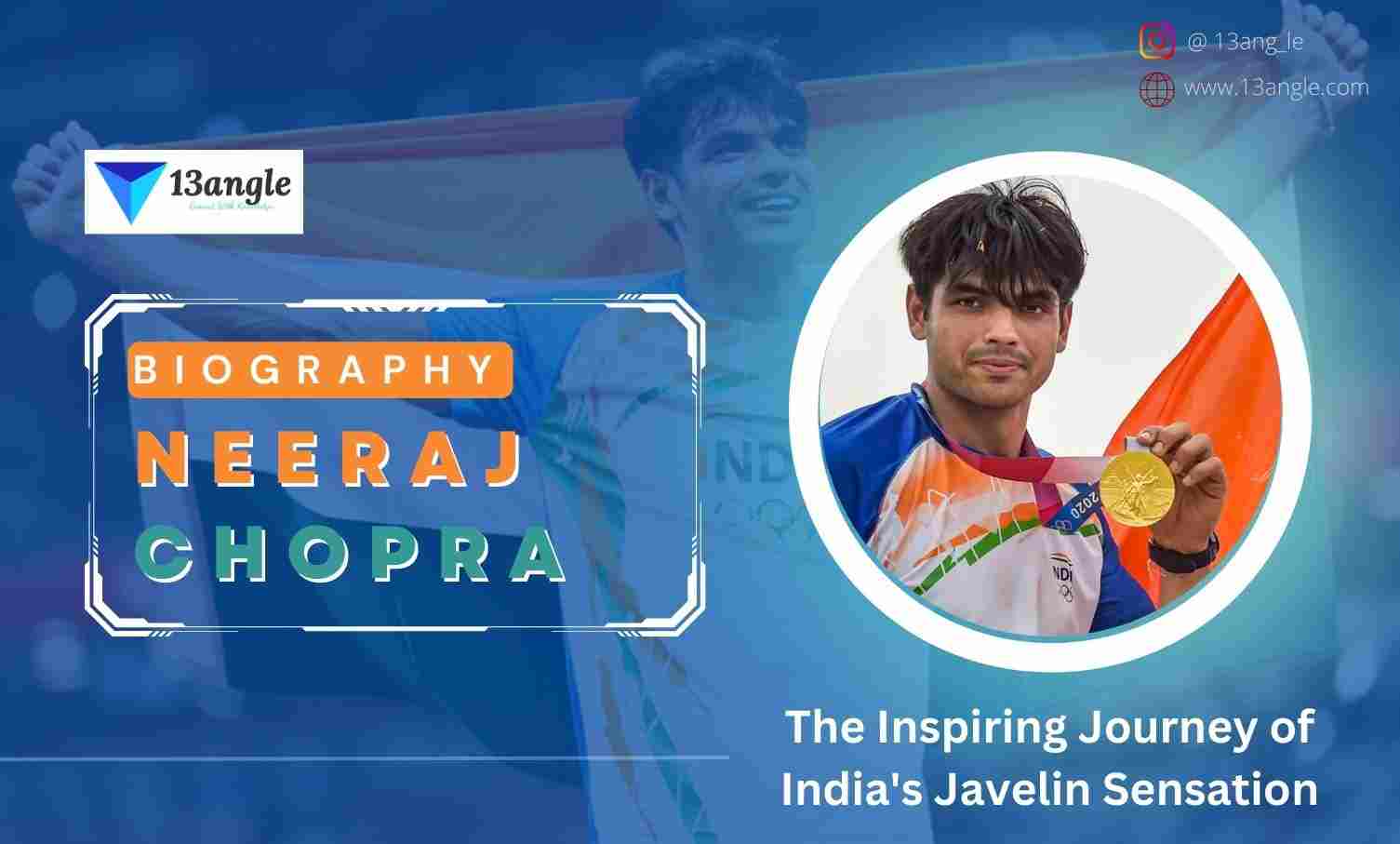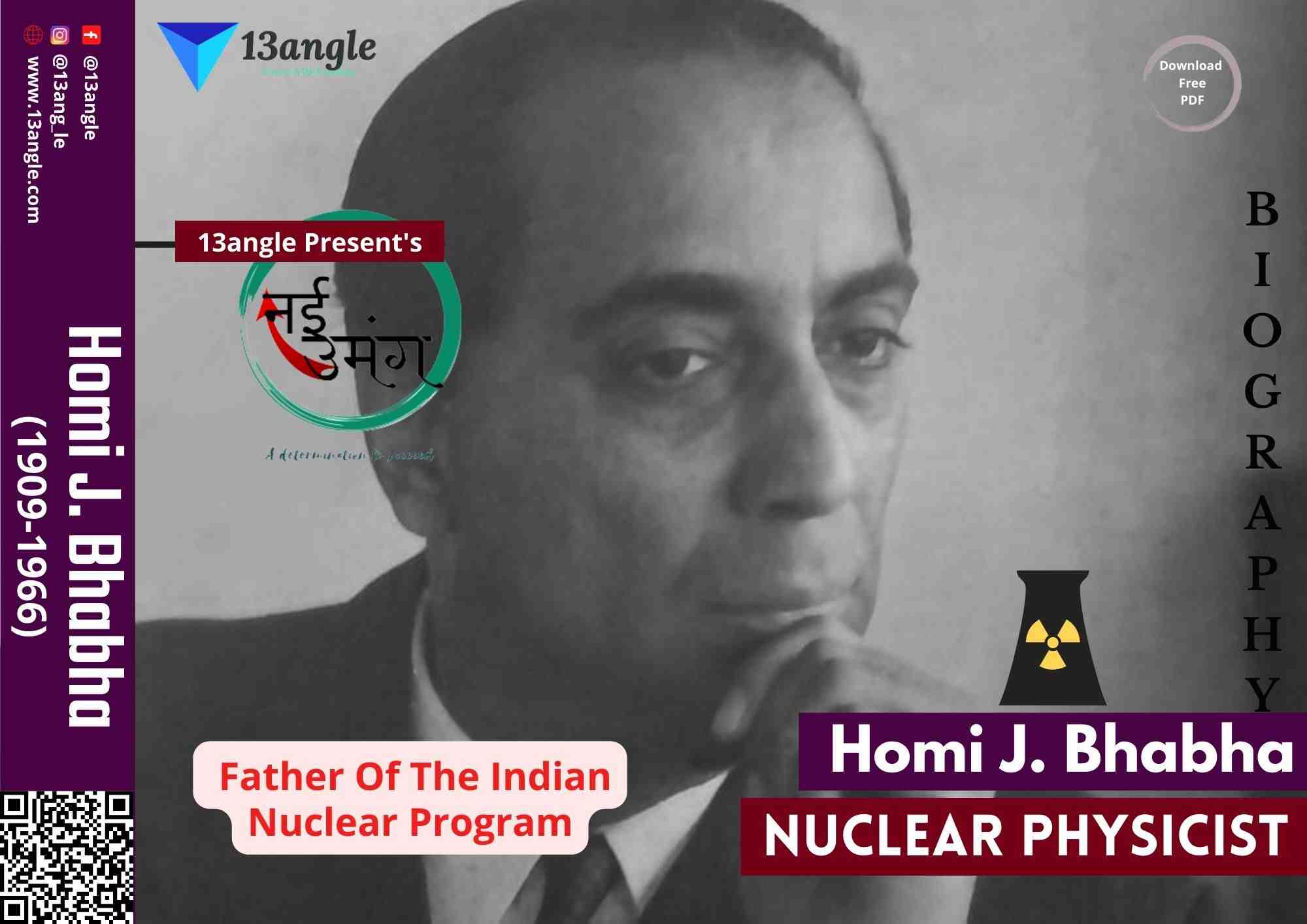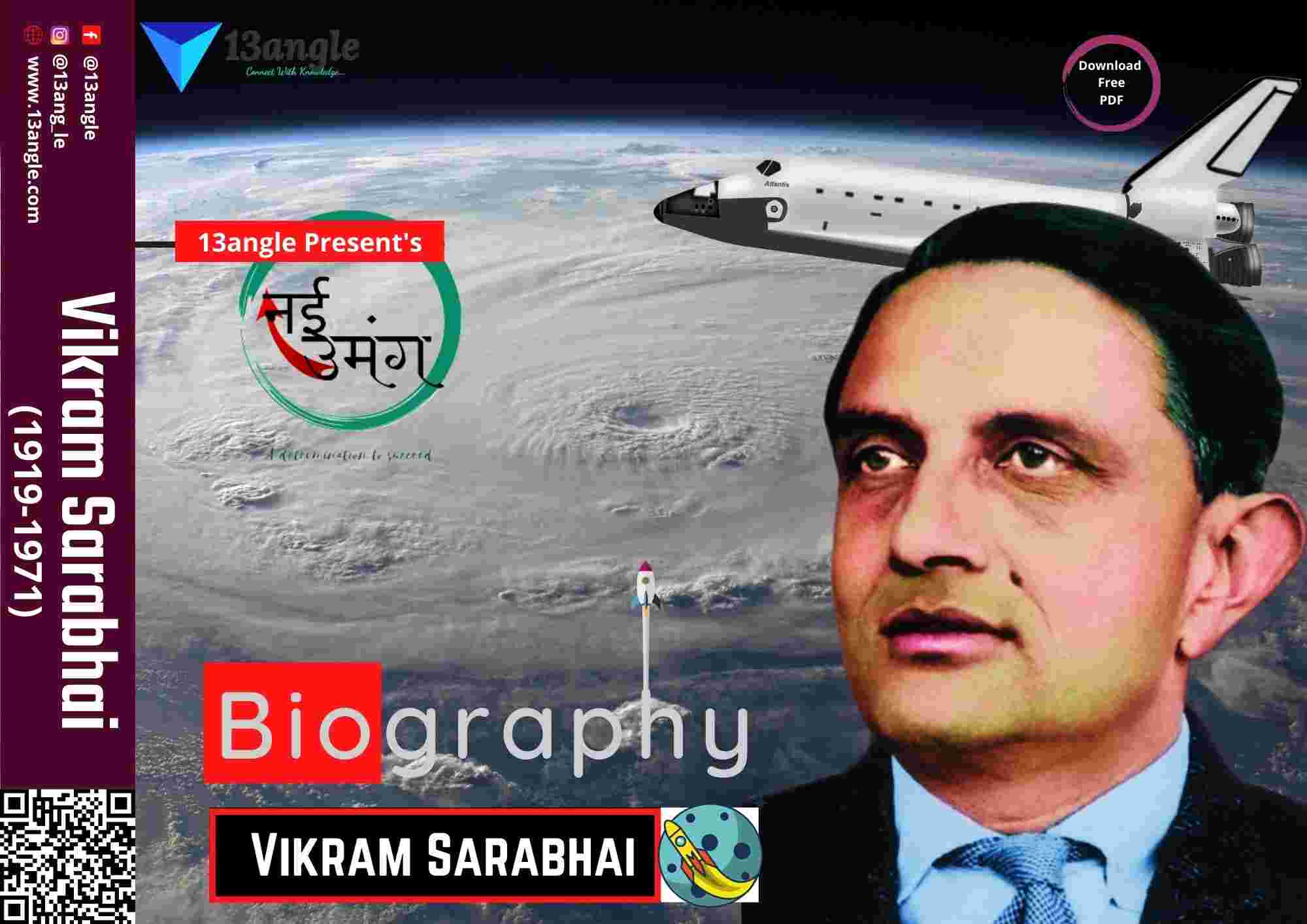Introduction
- Sushruta was the first Indian to practice surgery and study medicine. He was born in 800 BCE in the Kingdom of Kashi, he practiced medicine in northern India around the region of modern-day Varanasi (Benares) by the banks of the Ganges River. He died in 700 BCE in the kingdom of Kashi. Sushruta is the most celebrated physician and surgeon in India.
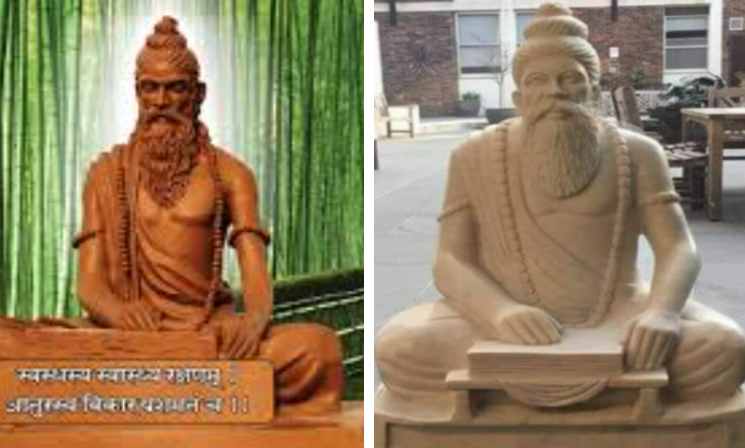
Sushruta: Father Of Surgery
- Sushruta Kashiraj is among the 12 disciples of Divodas Dhanvantri. He has been associated with the Sushruta mentioned in the Mahabharata, the son of the sage Visvamitra. He was an ancient Indian physician and surgeon known as the “Father of Surgery” and “Father of Plastic Surgery” or “father of brain surgery” for inventing and developing surgical procedures. He was regarded as a great healer and sage whose gifts were thought to have been given by the gods. According to legend, the gods passed their medical insight down to the sage Dhanvantari who taught it to his follower Divodasa, who then instructed Sushruta. For Sushruta, the concept of surgical science (shalyatantra) was all- encompassing. He developed many unique and practical techniques to dissect the human body and study its structure. The practice of surgery was already long established in India by the time of Sushruta but in a less-advanced form than what he practiced. He significantly developed different surgical techniques (such as using the head of an ant to sew sutures).He described six varieties of accidental injuries encompassing all parts of the body. They are described below:

1. Chinna– Complete severance of a part or whole of a limb
2. Bhinna– Deep injury to some hollow region by a long piercing object
3. Viddha Prana– Puncturing a structure without a hollow
4. Kshata– Uneven injuries with signs of both Chinna and Bhinna, i.e., laceration
5. Pichchita– Crushed injury due to a fall or blow
6. Ghrsta– Superficial abrasion of the skin.
His teaching of anatomy, pathophysiology and therapeutic strategies were of unparalleled luminosity, especially considering his time in the historical record. He is notably famous for nasal reconstruction, which can be traced throughout the literature from his depiction within the Vedic period of Hindu medicine to the era of Tagliacozzi during Renaissance Italy to modern-day surgical practices. The primary focus of this historical review is centered on Sushruta’s anatomical and surgical knowledge and his creation of the cheek flap for nasal reconstruction and its transition to the “Indian method.” The influential nature of the Sushruta Samhita, the compendium documenting Sushruta’s theories about medicine, is supported not only by anatomical knowledge and surgical procedural descriptions contained within its pages but by the creative approaches that still hold true today.
The highlight of Sushruta’s surgical magnificence was the surgery of nasal reconstruction or rhinoplasty (repairing the disfigured nose with a flap of skin from the forehead) that he used to reconstruct noses that were amputated as a punishment for crime. The technique is practiced almost unchanged to this day, the pedicle forehead flap being named the Indian flap. This knowledge of plastic surgery existed in India up to the late 18th century.
Many of his contributions to medicines and surgery preceded similar discoveries in the Western world. Sushruta devotees a complete volume of his experiences with ophthalmologic diseases. In Uttar, Tantrum Sushruta enumerates sophisticated classification of eye disease complete with signs, symptoms, prognosis, and medical/surgical interventions. In particular, Sushruta describes what may have been the first extracapsular cataract surgery using a sharply pointed instrument with the handle fashioned into a trough. His ability to manage many common eye conditions of the time with limited diagnostic aids is a testament to his virtuosity.
His Work And Discoveries
This knowledge of anatomy enabled Sushruta to document every minute detail of the organs, tissues, blood vessels, nerves, bones, and joints, with reference to their structure, quantity, shape and size. Some of the Sushruta work is listed below;
Rhinoplasty (cheek)
The practice of surgery was already long established in India by the time of Sushruta but in a less-advanced form than what he practiced. He significantly developed different surgical techniques (such as using the head of an ant to sew sutures) and, most notably, invented the practice of cosmetic surgery. His specialty was rhinoplasty, the reconstruction of the nose, and his book instructs others on exactly how a surgeon should proceed:
“The portion of the nose to be covered should be first measured with a leaf. Then a piece of skin of the required size should be dissected from the living skin of the cheek and turned back to cover the nose keeping a small pedicle attached to the cheek. The part of the nose to which the skin is to be attached should be made raw by cutting the nasal stump with a knife. The physician then should place the skin on the nose and stitch the two parts swiftly, keeping the skin properly elevated by inserting two tubes of eranda (the castor-oil plant) in the position of the nostrils so that the new nose gets proper shape. The skin thus properly adjusted, it should then be sprinkled with a powder of liquorice, red sandal-wood, and barberry plant. Finally, it should be covered with cotton and clean sesame oil should be constantly applied. When the skin has united and granulated, if the nose is too short or too long, the middle of the flap should be divided and an endeavor made to enlarge or shorten it.”
Classification of burns into four degrees and explaining the effect of heatstroke, frostbite, and lightning injuries
Advocated the practice of mock operations on inanimate objects such as watermelons, clay plots, and reeds.
A code of ethics for teachers as well as students.
Classification of eye diseases with signs, symptoms, prognosis, medical/surgical interventions, and cataract surgery
Introduction of wine to dull the pain of surgical incisions:
Classified details of the six types of dislocations, twelve varieties of fractures, and classification of the bones and their reaction to the injuries.
Invented the practice of cosmetic surgery.
His work and knowledge include medicines, plastic surgery, dentistry, obstetrics, and gynecology.
Sushruta also prescribed measures to induce growth of lost hair and removal of unwanted hair.
He implored surgeons to achieve perfect healing which is characterized by the absence of any elevation, induration, swelling mass, and the return of normal coloring.
Sushruta describes the ideal medical practitioner, focusing on a nurse, in this way:
“That person alone is fit to nurse or to attend the bedside of a patient, who is cool-headed and pleasant in his demeanor, does not speak ill of anyone, is strong and attentive to the requirements of the sick, and strictly and indefatigably follows the instructions of the physician.”
Sushruta Samhita
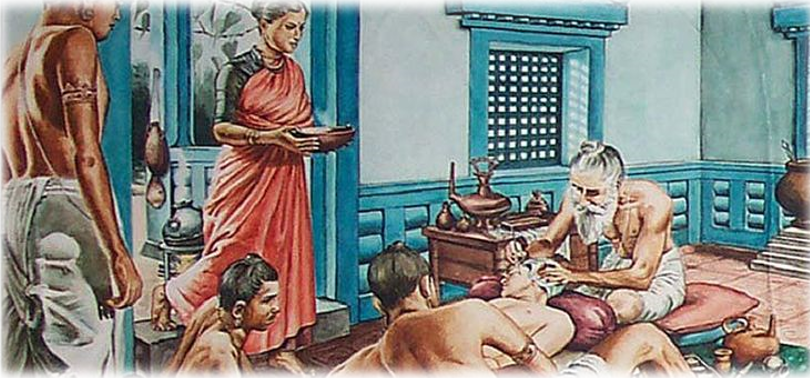
Sushruta is known for his pioneering operations and techniques and for his influential treatise ‘Sushruta Samhita’ or Compendium of Sushruta, the main source of knowledge about surgery in ancient India. The treatise addresses all aspects of general medicine. It is an instruction manual for physicians to treat their patients holistically. Disease, he claimed (following the precepts of Charaka), was caused by an imbalance in the body, and it was the physician’s duty to help others maintain balance or to restore it if it had been lost. To this end, anyone who was engaged in the practice of medicine had to be balanced themselves. Sushruta describes the ideal medical practitioner, focusing on a nurse, in this way:
“That person alone is fit to nurse or to attend the bedside of a patient, who is cool-headed and pleasant in his demeanor, does not speak ill of anyone, is strong and attentive to the requirements of the sick, and strictly and indefatigably follows the instructions of the physician. “
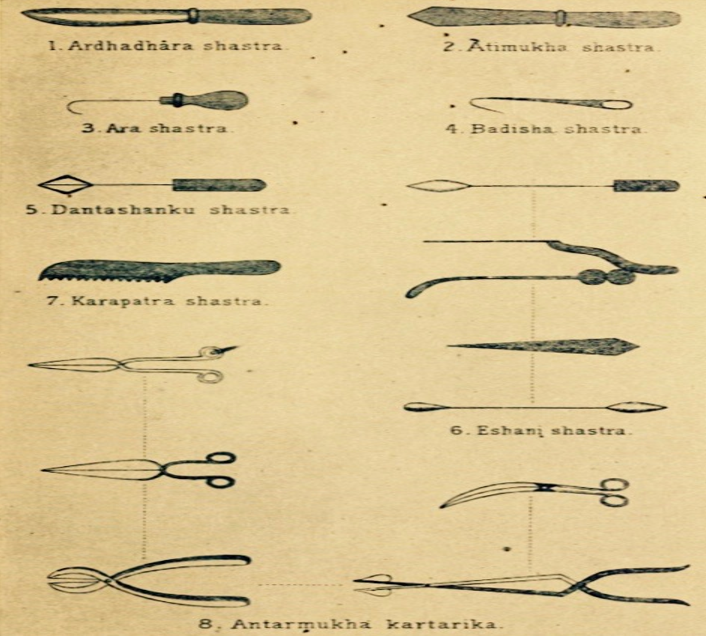
Written in Sanskrit, the Sushruta Samhita dates back to the times before Christ and is one of the earliest works in the field of medicine. It forms the foundations of the ancient Hindu form of medicine known as Ayurveda and is highly regarded as one of the ‘Great Trilogy of Ayurvedic Medicine.’ The Suśruta-saṃhitā, in its extant form, in 184 chapters contains descriptions of 1,120 illnesses, 700 medicinal plants, 64 preparations from mineral sources, and 57 preparations based on animal sources. The text discusses surgical techniques of making incisions, probing, extraction of foreign bodies, alkali and thermal cauterization, tooth extraction, excisions, and trocars for draining the abscess, draining hydrocele and ascitic fluid, removal of the prostate gland, urethral stricture dilatation, vesicolithotomy, hernia surgery, caesarian section, management of haemorrhoids, fistulae, laparotomy and management of intestinal obstruction, perforated intestines and accidental perforation of the abdomen with protrusion of omentum and the principles of fracture management, viz., traction, manipulation, apposition, and stabilization including some measures of rehabilitation and fitting of prosthetic. It enumerates six types of dislocations, twelve varieties of fractures, and classification of the bones and their reaction to the injuries, and gives a classification of eye diseases including cataract surgery. The Sushruta Samhita documented the etiology of more than 1,100 diseases, the use of hundreds of medicinal plants, and instructions for performing scores of surgical procedures – including three types of skin grafts and reconstruction of the nose.
- Skin grafts entail transplanting pieces of skin from one part of the body to another. Today, surgeons use skin grafts to restore areas that have lost protective layers of tissue due to trauma, infection, burns, as well as to restore areas where surgical intervention has created a loss of skin, as can happen with melanoma removal. Some grafts include blood vessels and muscle, such as in reconstructive breast surgery.
Origin Of Rhinoplasty
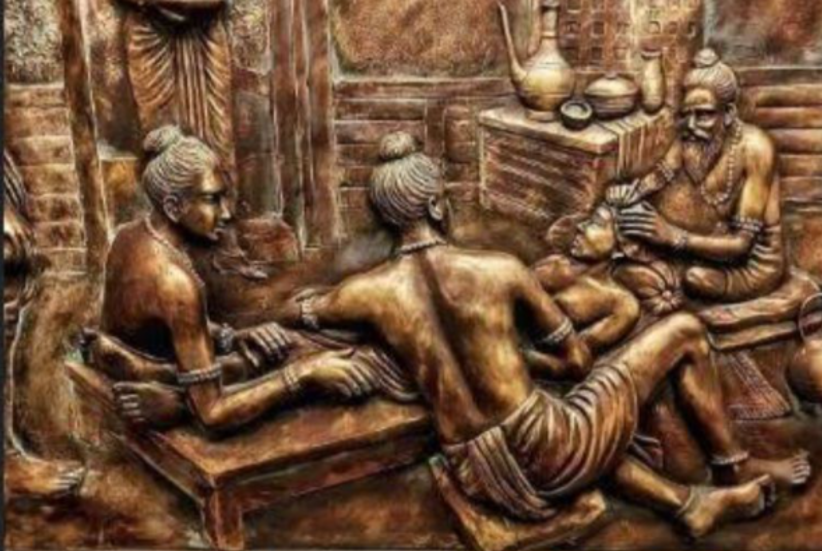
Rhinoplasty, colloquially known as the ‘nose job,’ is a surgery performed to achieve two results:
To improve the breathing function of the nose.
To improve the cosmetic look of the nose.
Sushruta’s treatise provides the first written record of a forehead flap rhinoplasty, a technique still used today to reconstruct a nose. He used a flap of skin from the forehead, called a pedicle, to form a new nose. The nose in Indian society has remained a symbol of dignity and respect throughout antiquity. In ancient times, amputation of the nose was frequently done as a punishment for criminals, war prisoners or people who indulged in adultery. The practice of Rhinoplasty slowly started as a result of the need to reconstruct the external nose and later developed to full-fledged science.
The influential nature of the Sushruta Samhita is supported not only by anatomical knowledge and surgical procedural descriptions contained within its pages but also by the creative approaches that still hold true today.
Golden Age Of Surgery

Sushruta took surgery in medieval India to admirable heights and that era was later regarded as the ‘Golden Age of Surgery’ in ancient India.
To Sushruta, health was not only a state of physical well-being but also mental, brought about and preserved by the maintenance of balanced humors, good nutrition, proper elimination of wastes, and a pleasant contented state of body and mind.
Sushruta: An Ophthalmologist

The eyeball (Nayana-Budbuda), as described by Sushruta, is two fingers in transverse diameter, breadth of one’s own thumb in-depth (sagittal diameter), and two fingers and a half all around (in circumference). It is made up of all the five primary elements of the universe which includes the solid earth (Bhu) forming the muscles, heat (Agni) forming the blood, the gas (Vayu) forming the iris in which the pupil is situated, fluid (Jala) forming the vitreous, and the void space (ethereal akasa) forming the lacrimal apparatus and other ducts and sacs. The major division of the eye consisted of five mandalas (a subdivision of circles of the eyeball which includes Krishna mandala – the choroid layer and other four (6 sandhis/joints, where the subdivision meets one another), and 6 patalas (layers or coats).
The main culprits of eyes diseases, according to Sushruta, are diving in water after prolonged exposure to heat/sun, constant near or far gazing, sleep during the day and waking up late nights, grief, worry, alcohol consumption, trickling of sweat in the eyes, dust/smoke exposure, excessive vomiting, etc.
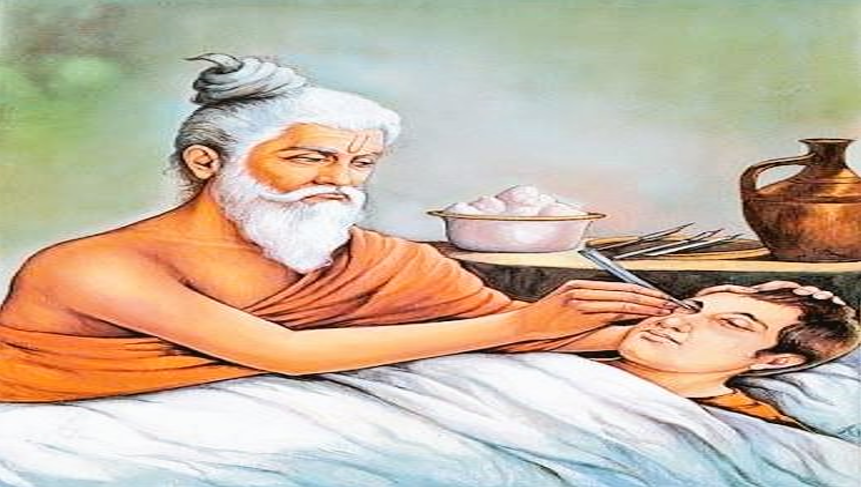
- Different treatment modalities are described such as medicinal measures (Kriya), soothing (Tarpara), a sprinkling (Seka), eye drops (A’schyotana), and eye slaves (Puta-pakas Anjanas). Most of the time, the treatment for ophthalmic diseases was done by laying the patient in a dark chamber not exposed to the sun and the gusts of wind after having been treated with proper emulsive measures (snehakarma) and subjected to a course of emetics and purgatives. Most of the time, at the end of the surgery, a paste of honey and clarified butter were applied, and then the eye was bandaged. We are all well aware of the process known as couching which originated in India. It is still practiced in some rural parts of India. Different needles, which were either straight or slightly curved, were used by Sushruta according to the nature of the lens material (milky, gray, and fluffy). Yuv-vakra salaka is one example used for cataracts. The needles, used for cataract surgery, had to be made up of gold, iron, or copper. They had strung around the other end. The technique of couching is described beautifully in the Samhita. The left eye was operated with the right hand and vice versa. The needle was inserted at the exact site as described. The success of the operation was presumed from the characteristic report or the sound and the emission of a drop of water from the affected region following perforation. Then the eye was fomented with the needle in situ. The mucus accumulated in the affected eye after the surgery was removed by asking the patient to snuff it off by closing the nostrils on the other side of the operated eyeball. The eyes were bandaged after the application of emulsions (ghee and honey), removed every 4th day, and fomented till the 10th day of surgery. If the surgery is not done properly, blood would come out from the perforated site which should be then sprinkled with breast milk and bandaged.
Sushruta: A Guru
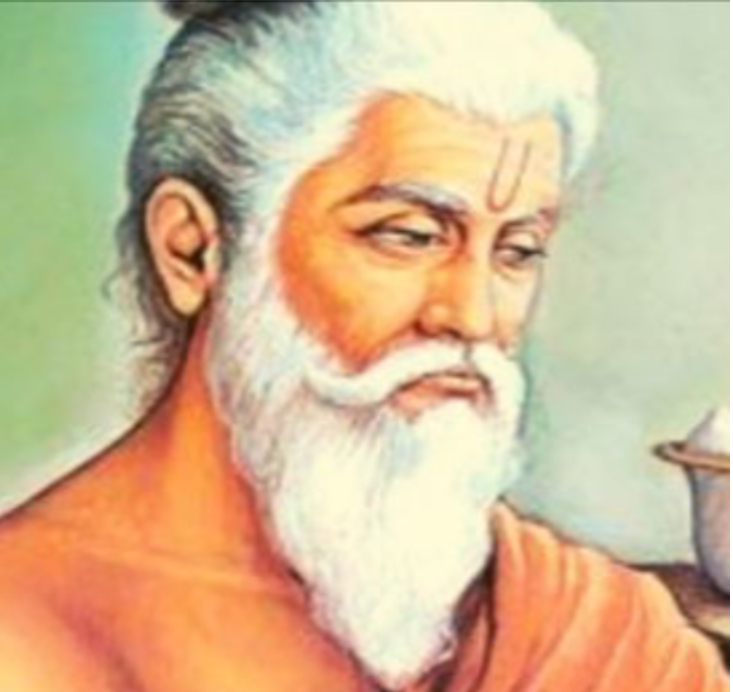
- Sushruta attracted a number of disciples who were known as Saushrutas and were required to study for six years before they even began hands-on training in surgery. Before starting their training, they had to take a solemn oath to devote themselves to healing and to do no harm to others; which can be compared to Hippocratic Oath. After the students had been accepted by Sushruta, he would instruct them in surgical procedures by having them practice cutting on vegetables or dead animals to perfect the length and depth of an incision. Once students had proven themselves capable with vegetation, animal corpses, or with soft or rotting wood – and had carefully observed actual procedures on patients – they were then allowed to perform their own surgeries.
The definition of an ideal surgeon according to the great surgeon Sushruta is:
“A person who possesses courage and presence of mind, a hand free from perspiration, tremor less grip of sharp and good instruments and who carries his operations to the success and advantage of his patient who has entrusted his life to the surgeon. The surgeon should respect this absolute surrender and treat his patient as his own son.”
- These students were trained by their master in every aspect of the medical arts, including anatomy.
Conclusion
- Sushruta considered surgery the first and foremost branch of medicine and stated that surgery has the superior advantage of producing instantaneous effects by means of surgical instruments and appliances and hence is the highest in value of all the medical tantras. It is the eternal source of infinite piety, imports fame, and opens the gates of heaven to its votaries. In “The source book of plastic surgery”, Frank McDowell aptly described Sushruta as “through all of Sushruta’s flowery language, incantations and irrelevancies, there shines the unmistakable picture of a great surgeon . Undaunted by his failures, unimpressed by his successes, he sought the truth unceasingly and passed it on to those who followed. He attacked disease and deformity definitively, with reasoned and logical methods. When the path did not exist, he made one.”It prolongs the duration of human existence on earth and helps humans in successfully completing their missions and wearing a decent competence in life., “All in all, Sushruta must be considered the greatest surgeon of the pre-medieval period.”
Top 13 Interesting Facts About Sushruta
-
For successful surgery, Sushruta induced anesthesia using intoxicants such as wine and henbane
-
Sushruta was also known as a medical authority in Tibetan literature.
-
The Sushruta Samahita also traveled from India to other parts of the world.
-
Besides trauma involving general surgery, Sushruta gave an in-depth account of the treatment of 12 varieties of fracture and six types of dislocation. This continues to spellbind orthopedic surgeons even today.
-
He mentioned the principles of traction, manipulation, apposition, stabilization, and postoperative physiotherapy.
-
Sushruta Schools welcomed the students of all four castes, including the Shudras.
-
The Sushruta Samhita was divided into six major sections — the Sutrasthanam, the Nidhanasthan, Sharesrasthanam, Chikitsasthanam, Kalpasthanam, Uttaratantrum.
-
All those who learned Shalya tantra (the art of surgery) became surgeons and were designated with the title “Dhanwantari”.
-
The tradition of ancient surgeons or Dhanwantri is called “Dhanwantareeya”.
-
Shalya Tantra was given the top priority in terms of teaching, preaching, and practicing.
-
Sushruta discovered 76 kinds of eye diseases.
-
Sushruta believed in the concept of practicality and hence made his students practice vegetables.
-
Sushruta was the name of the clan to which Vishvamitra belonged.

